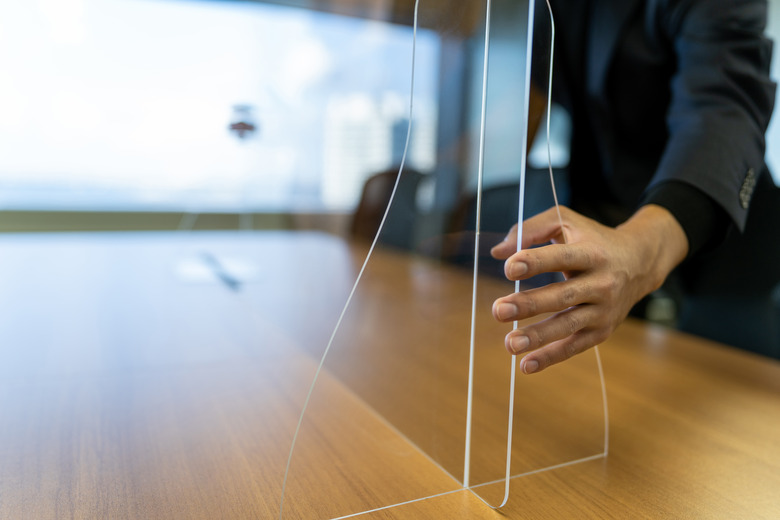The Best Way To Remove The Plastic Film From Plexiglass
We may receive a commission on purchases made from links.
People buy name-brand Plexiglas and its lookalikes (colloquially known as "plexiglass") for a clear, glasslike finish. To ensure this is what customers get, manufacturers apply a protective plastic film to keep it looking pristine until it's installed. Removing the protective film from plexiglass or acrylic should be relatively simple, but that's not always the case. When conditions cause the film to harden or begin fusing to the plexiglass, you'll want to coax it off without damaging the product.
How It Should Go Normally
How It Should Go Normally
If your plexiglass is straight from the retailer, it shouldn't be too tough to remove the film. Simply lift it on a corner and slowly peel it up and off in one long, consistent action. Lifting the film is simple — use a fingernail or tweezers or even lay a strip of tape on top to help pull it up.
It can be difficult to pull off the plastic. It's designed to withstand the rigors of shipping and delivery, after all. One trick the professionals use is to have an old paper cylinder, like a poster tube, and lift up a bit of the film, hold it against the tube, and slowly roll away from you. The goal is to "roll up" the film like you would with carpet using the cylinder as the spool.
Film Removed? Time to Clean
Film Removed? Time to Clean
Once you've removed the film, there shouldn't be any residue remaining, but that doesn't mean it'll be clean. There may be streaks, or you might see lines from where you paused when removing the film, but these should clean off easily.
Cleaning can be tricky with plexiglass, and it's why there's a whole product line dedicated to cleaning plastics and acrylics. Plexiglass is by design easy to cut and alter as a DIY project. That's why the wrong cleaner will damage the surface of the acrylic sheet, either scratching it or causing it to become cloudy, almost like frosted glass. It's highly recommended that you invest in a quality acrylic cleaner and use it as the manufacturer specifies. If you've damaged the surface, you may be able to buff it out, but you may also damage it further with such efforts.
When the Film Is Stuck
When the Film Is Stuck
Manufacturers intend for you to remove the protective film within two years, and they expect it to be stored in a cool, dark place. Inevitably, the adhesive dries out, and the film adheres to the product. Perhaps you've had that sheet of acrylic in the back of your shed for five years, or maybe the previous homeowners left that basement window's plexiglass film on for additional insulation. Whatever the case, conditions can cause the film to harden and become less cooperative if not nearly impossible to remove.
Soaking the plexiglass in warm water can help remove the film, but the trick is that it can't be too warm, or it can damage the acrylic. Hence, a heat gun or hair dryer can be helpful but can also damage the product beyond repair, so use heat cautiously.
If you're meeting resistance with heat, you may be forced to turn to more intensive solvents and chemicals. Framing companies will routinely work with acrylics and use products like kerosene, hexane, and aliphatic naphtha to apply to the surface and remove stubborn films. Proper use of each of these varies, and the manufacturer's instructions will help, but you'll need to work safely in a well-ventilated space with protective gear, including a face mask and eye protection. Once the solvent does its work, the plastic film should bubble and lift, but it may still be hardened, in which case a plastic razor blade (never metal!) should help you scrape it all away.
If you remain vexed by the protective film, consider enlisting the help of a local framing shop or acrylics retailer. Avoid these struggles by using acrylic sheeting or plexiglass within two years and promptly remove the film at that time.
